
Burbot recovery in Lower Kootenay will begin in spawning season
The Province’s fish biologists and international co-managers will be on Moyie Lake in February to catch, tag and release burbot as part of egg collection to support recovery in the Kootenay River and Kootenay Lake.
The egg-collection project is part of successful recovery efforts for the Lower Kootenay burbot population downstream of Libby Dam in Montana to Kootenay Lake in B.C.
The Lower Kootenay burbot population once supported First Nations fisheries as well as recreational fisheries in Montana, Idaho and British Columbia. The population was recognized to be at risk of extirpation during the mid-1990s. When fewer than 50 adult fish were left in the river, a conservation strategy was signed by international co-managers in 2005, including the Government of B.C., Kootenai Tribe of Idaho, Ktunaxa Nation Council, Idaho Department of Fish and Game, Montana Fish Wildlife and Parks, U.S. Army Corps of Engineers and the University of Idaho.
As part of the Lower Kootenay burbot recovery program, which began in 2009, fertilized eggs from Moyie Lake were successfully raised in a hatchery in Idaho and released back into Kootenay Lake and the Kootenay River.
As of today, hatchery-released burbot are surviving well in the Lower Kootenay system. However, due to habitat limitations from the Libby Dam and floodplain alterations along the Kootenay River, burbot are not spawning successfully in the river. Moyie Lake egg collections are therefore an essential component of the hatchery production until wild spawning is restored.
The Ministry of Water, Land and Resource Stewardship continuously monitors the Moyie Lake burbot population because it is a popular sport and subsistence fishery as well as a crucial part of the Lower Kootenay burbot recovery program. Data collected over the duration of this program confirm that Moyie Lake has a healthy burbot population with approximately 10,000 adult fish.
An average of 360 fish are handled during the egg-collection efforts in the February spawning period, which is a very low percentage of the estimated spawning population. Biologists collect approximately 0.03% of Moyie Lake’s available eggs per year. All burbot handled in the program are tagged and released alive.
Incidentally, a filming crew will be on Moyie Lake for underwater footage of burbot for a freshwater fish documentary during the same time as egg collection. The activities of the film crew are separate from and unconnected to the burbot recovery program.
Members of the public can help refine burbot population estimates by calling 250 354-6333 when they catch a fish with a tag. In addition to the tag number, anglers are asked to include a description of the location and accurate length, weight and sex of the fish. Certain tags identify a reward for the person who finds them. If found, people are asked to take a clear photo of the tag or mail it to the regional office, after calling 250 354-6333.
Learn More
For more on Kootenay regional fisheries information, vist: https://www2.gov.bc.ca/gov/content/environment/plants-animals-ecosystems/fish/fish-management/region-4-kootenay
